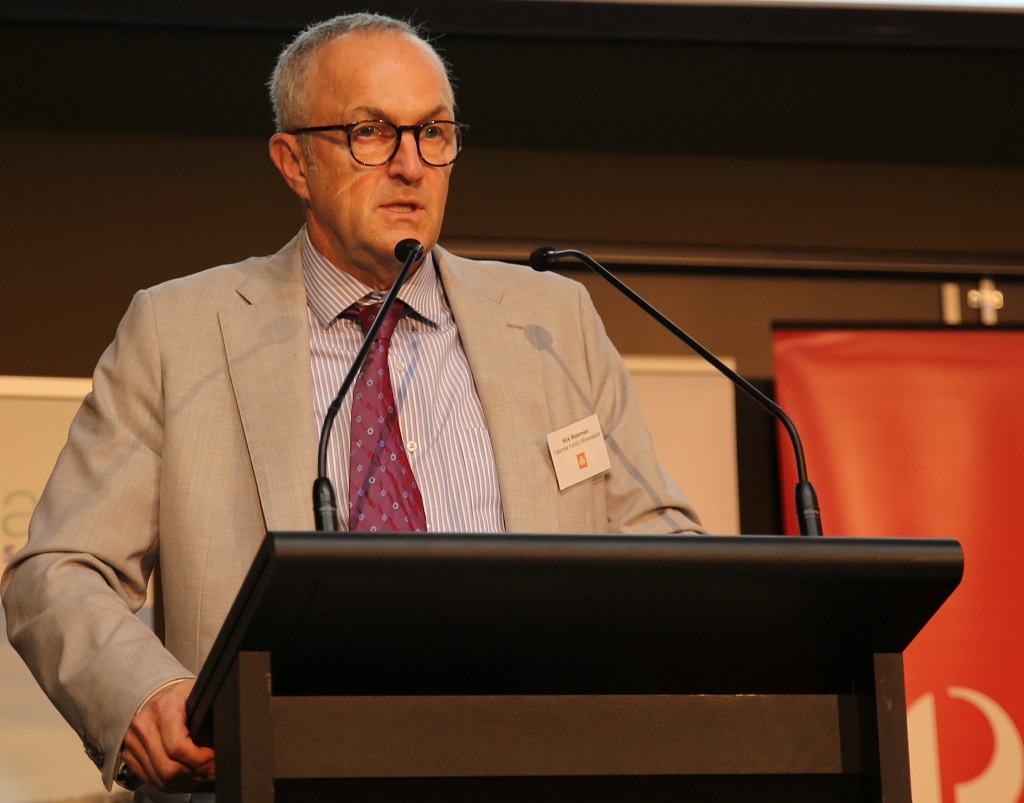Image: Nick Waterman, president and chair of the South Australian Wine Industry Association.
By Sonya Logan
The fallout from China’s decision to impose duties on imports of bottled still wines from Australia will be largely shared by the nation’s family wine businesses and the grapegrowers who supplied fruit to the more than 1000 trading companies that took advantage of Australia’s export success in the country, said Nick Waterman, the president and chair of the South Australian Wine Industry Association (SAWIA).
Waterman, who is also managing director of family-owned wine company Yalumba Family Winemakers, was speaking at SAWIA’s annual luncheon at the National Wine Centre in Adelaide last Thursday (30 September). He said the anti-dumping duties — which will apply to still wine in containers of 2 litres or less until March 2026 and range from 116.2% to 218.4% — would have minimal effect on Australia’s top wine exporters to China.
“If one is to look at the pain points from the China fallout, I believe that it will not be felt by the top six exporters. Those six exporters account for 42% of the value of all the business of exports to China. And those companies, in the main, have other routes to market and can absorb and adjust their business accordingly,” Waterman said.
He said the bulk of “the pain” from the loss of China would be felt by the 372 mostly family-owned wine businesses that faced “a combined loss of sales of $120 million” and the growers who provided grapes to “some 1500 traders” which were then made into wine and sold into China “off the back of the strength of Brand Australia”.
“Those 1500 traders represented 48% of the value of exports, or a total of $570 million,” continued Waterman, “It’s not the traders that we’re, from an industry point of view, concerned about, although we feel for them, because they’ll turn their focus to other business pursuits. But for the growers who supplied the grapes to those trading companies, they will feel the pain as many will have to significantly reduce the price of their grapes or end up pursuing the bulk market.
“And I know that there’s a lot of wine sitting in tanks around the country that shouldn’t be there at the moment and leading into the 2022 vintage is when the pain will be felt, and that’s going to be most felt by the grower community in regional South Australia. The immediate impact is already being seen in downward pressure on grape prices.”
Waterman said a recent report by the Australian Bureau of Agricultural and Resource Economics and Sciences estimated that by 2025, only 60% of Australia’s wine exports originally destined for China that year would be redirected to other markets.
“Prior to the China tariffs, China represented 40% of the value of Australian exports, but only 10% of the total volume of the national crush. But when you consider that the 2021 crush was 16% higher than the long term average, we have a national short term surplus of around 25%. And to put that into perspective, that’s a surplus of around 425,000 tonnes.”
Waterman said that on a positive note, consumers all over the world continued to enjoy wine.
“And whilst there’s been a significant skew towards retail and online sales, total global consumption levels have remained relatively stable.
“Our thoughts are with those on-premise businesses who have faced numerous shutdowns at ever-increasing short notice. These restaurants, cafes, pubs and clubs, play a pivotal role in building brands and provide a vital route to consumers for the many wineries, particularly the small to medium sized family businesses.
“Having talked to many on-premise accounts, both large and small, over the last six or seven months, I know there is a serious issue in terms of lack of hospitality for staff to meet the demand of the venues. And when the country opens up I think it’s going to be a significant challenge for the hospitality sector,” Waterman said.
He added that SAWIA was in the process of finalising a paper that will be delivered to the South Australian Government and opposition to identify the key immediate and medium term issues facing the state’s wine industry.
“The focus will be on short-term labour issues ahead of vintage next year, the challenges of profitability, driving tourism once state and national borders are open to facilitate international trade, infrastructure and water scarcity,” Waterman revealed.
Are you a Daily Wine News subscriber? If not, click here to join our mailing list. It’s free!
















